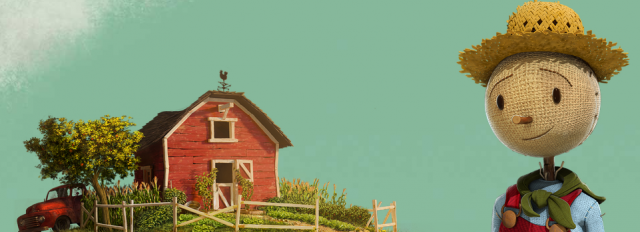This article was contributed by Joan Selby.
People have been telling stories since the dawn of time. It is how they entertain, educate, motivate, and preserve their culture.

Before there was writing, people relied on oral tradition for tales of valor, experiences, and origin of things. Much of our cultural history is based on stories handed down from generation to generation in the form of songs, dance, and rituals. Ancient pictures on cave walls and rocks served as records of times past, providing us with a fascinating saga of how our ancestors lived.

When you think about brand building, isn’t that precisely what you are trying to do? You are telling your target market a story—the story of your brand.
It is not enough to communicate your brand’s story in the About page of your website. It needs to be a continuous, seamless effort that reinforces their initial interest, so that your audience will follow you through your progress.
What better to get this done than by actually using storytelling as a medium?
Your content and blog posts are an excellent way to tell your story if only you knew how to make them interesting. It isn’t easy, but it is important to learn. Here are three storytelling techniques to make your posts brilliant.
1. Leverage the archetype of the hero and his enemy
Every story has a hero, but the story would not be interesting if there were no villains.
Your brand is the hero, and your enemy is anything that your brand has to beat. It does not have to be a person. It can be disease, the system, or even fear. You need to clearly define your hero and enemy in such a way that your audience can recognize and relate to them.
Create a character for both your hero and the enemy so that your audience can identify with both of them and take sides. Your characters have to be relevant to the audience, so they cannot be “perfect” in every way.
Think about Superman, who is the perfect hero but for one weakness – Kryptonite. Then think about Batman, who is full of flaws and have no superpowers, yet he puts his life on the line to battle villains and save Gotham City. Superman may be super, but most people can relate to Batman more.
A simple illustration of this point is “The Scarecrow” campaign by Chipotle. It used a short, poignant video to follow the life of a scarecrow (Chipotle) that worked for Crow Foods, an industrial farming company that has a monopoly on the land of Plenty. The scarecrow saw how the animals were mistreated, and how Crow Foods was using pesticides on vegetables. It was his job to help Crow Foods in “Feeding the World.” He was a little guy, no match for big business. He was, in other words, the underdog.

Go through the qualities of your protagonist and antagonist, and introduce your characters to your audience as dynamic concepts. Motivate your audience to follow your characters as they evolve through the story arc. Experiment with different combinations of qualities until you come up with a hero for which your audience can root. Your intention, of course, is to have your hero prevail over the enemy.
2. Find your hook
Characters are just one component of the story. Your story needs a theme or plot, and it should always have an element of conflict.
In book ‘Winning the Story Wars’, Jonah Sachs writing about new marketing strategy that ‘inspires action by painting a picture of an imperfect world that can be repaired through heroic action’ (Sachs, J. 2012)

In “The Scarecrow,” the hero of the story was unhappy with what he was doing. He needed a job, but his conscience was bothering him. An idea struck him when he came home one day and saw his vegetable garden. Why not give people something fresh and natural to eat? He quit his job and opened a food stall. This is where the video ended, but the campaign continues into the game, where you can control how the story goes.
Nobody wants to read a love story where the hero finds love with nary a hitch. That’s just boring. You have to place obstacles along the way to make your hero’s journey interesting and exciting. In the above example, the hero’s dilemma is choosing between his livelihood and his conscience, and, of course, his conscience won. He would deliver “Food with Integrity.” The exciting part comes with the game, where the real battle between David and Goliath takes place. Unfortunately, it is only compatible with Apple iPhone 4S, iPad2 and newer devices.
When finding your own hook, you don’t even have to invent anything from whole cloth. All brands go through a period of development where some things simply don’t work out. Use that to define your overall theme.
Your conflict in terms of brand marketing may be overcoming initial resistance to your product, or your problems with getting funding for research and development. You could include stories about how experts shot down your ideas for a better product or service. You might even include stories about your first failures, and recount how you felt, what you did, and how you handled it.
Remember, you want your audience to see your brand as something that emerged victorious despite all the odds. Conflict arouses emotions in your audience, and you want them cheering you on.
3. Create compelling visuals
Stories are not only about words. People are visual creatures, and including illustrations, images and videos will make your story more compelling, emotional, and memorable.
Because your medium is static, you need visuals to bring your story to life. You can actually start your story with a bang by showing an image or video that captures their imagination. It can be an iconic image from a popular movie, or a video of your brand showing a problem.
If you are a detergent brand, for example, you can show an image of a muddy cute kid in his or her best clothes, saying with a wide-eyed expression in the caption, “Whaaaatt???” You have all the elements in there: cuteness, troubles, and humor.
Your visuals can convey a whole lot of meaning and impact without having to describe it in exhaustive detail. Besides, how can you describe terminal cuteness?

Chipotle chose to use poignancy as a way to appeal to emotions. The characters, the soundtrack, and the pace of the video emphasized the feeling of hopelessness and helplessness at the beginning, and then there was a subtle change in tempo when realization of what had to be done struck. The free downloadable app game picks up the pace, continuing the saga of the battle between good and evil.
As of September 1, 2016, Chipotle’s video has had 16 million views, and the comment section shows how the story has touched the hearts of the viewers. The games have been downloaded thousands of times.
Storytelling has been gaining traction in brand marketing as more brands continue to battle it out to produce good content that will gain audience attention. When you first get into it, it can be overwhelming, especially if you are used to churning out articles and blogs that have no beginning, middle, and end.
Good thing that these three techniques can help you get a handle on the situation. They are major features of storytelling on which you have to concentrate. Mastering these techniques can help you build your brand with ease, and enjoy doing it.
—
Joan Selby is a content marketer at Edugeeksclub.com which provides online assistance to students and supports them. Former teacher and fancy shoelover. A writer by day and reader by night. Find her on Twitter and Facebook.
hey
well i read your post and this fact that true that if we will put fact true storys on our blog so easily we can make Brilliant our site because everyone found a such a true storyies. nice advice, thanks for sharing.
Visuals can affect a post too fast. I prefer visuals more than text in all my posts, but all other points hold true also. Thanks for sharing!!
Ww, these amazing techniques. Thanks.
amazing…
these is amazing techniques
Storry telling is the best way to make our post to be loved,, haha
i was learn about this but i don’t know i always fail.
and now after i read your article every all be easy, it amazing artikel. thanks allot Joan Selby.